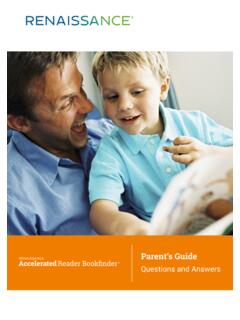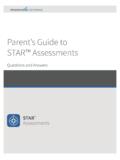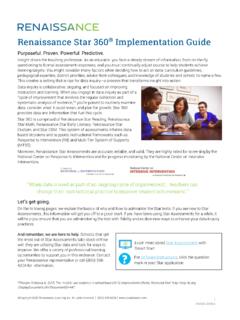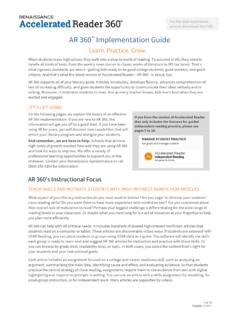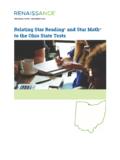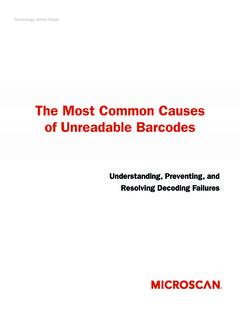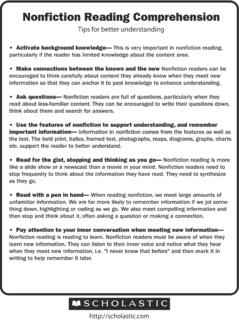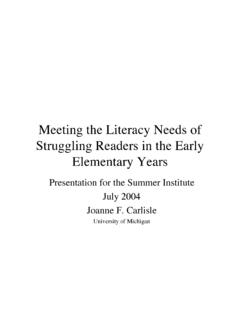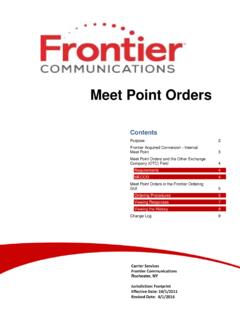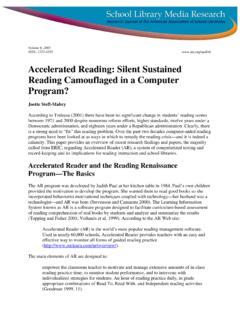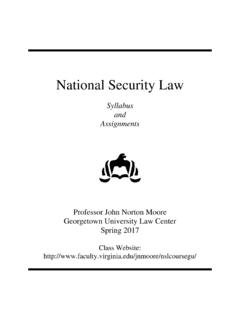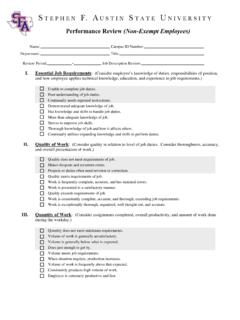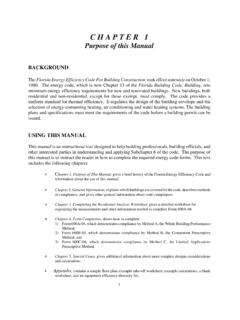Transcription of Accelerated Reader Meets the “Evidence - Based ...
1 Copyright 2019 Renaissance Learning, Inc. All rights reserved. (800) 338-4204 1 Accelerated Reader Meets the evidence - Based requirements of ESSA To meet the requirements of the Every Student Succeeds Act (ESSA), educators must select activities, strategies, or interventions that are evidence - Based . This document explains those standards, and how Renaissance Accelerated Reader Meets them. What is an evidence - Based intervention? Section 8101(21)(A) of the Elementary and Secondary Education Act (ESEA), as amended by ESSA1, defines evidence - Based as follows: (21) evidence - Based . (A) IN GENERAL. Except as provided in subparagraph (B), the term evidence - Based , when used with respect to a State, local educational agency, or school activity, means an activity, strategy, or intervention that (i) demonstrates a statistically significant effect on improving student outcomes or other relevant outcomes Based on (I) strong evidence from at least 1 well-designed and well-implemented experimental study; (II) moderate evidence from at least 1 well-designed and well-implemented quasi-experimental study.
2 Or (III) promising evidence from at least 1 well-designed and well-implemented correlational study with statistical controls for selection bias; or (ii)(I) demonstrates a rationale Based on high-quality research findings or positive evaluation that such activity, strategy, or intervention is likely to improve student outcomes or other relevant outcomes; and (II) includes ongoing efforts to examine the effects of such activity, strategy, or intervention. Department of Education Guidance on Using evidence In September 2016, the Department of Education issued a guidance document2 to provide state and local education agencies (SEAs and LEAs) with non-regulatory recommendations ( non-binding or legally enforced) for selecting and using evidence - Based interventions (used generally to mean any practices, activities, etc.)
3 , not just those aimed at struggling students). The guidance is split into two sections: Part I includes 5 steps that form a framework to guide an SEA s or LEA s choice of intervention and to strengthen its effectiveness once implemented: Step 1: Identify local needs Step 2: Select relevant, evidence - Based interventions Part II of the document is designed to help guide this step. 1 2 Copyright 2019 Renaissance Learning, Inc. All rights reserved. (800) 338-4204 2 Step 3: Plan for implementation Step 4: Implement This step acknowledges the importance of program implementation on an intervention s success.
4 There is an emphasis on collecting implementation data and using it to monitor and adjust the program. Step 5: Examine and reflect Suggests the use of performance monitoring to track progress toward program objectives and the use of evaluations of effectiveness that yield strong or moderate evidence to determine if desired outcomes were achieved. A free tool called RCT Yes 3 is suggested as a resource to aid in intervention-data analysis. These steps, framed as a cycle to promote continuous improvement, present a straightforward guide for SEA and LEA stakeholders to follow in their efforts to choose an evidence - Based intervention that will meet their needs, insure it is implemented well, and evaluate whether it attains the desired goals.
5 Part II of the document provides guidance to help stakeholders understand the meaning and depth of what constitutes an evidence - Based intervention, with the goal of allowing them to choose a well-supported intervention to implement (Part 1, Step 2), as well as help them to design a sufficiently rigorous evaluation of their chosen intervention once it is put into place (Part 1, Step 5). The definition of what qualifies as an evidence - Based intervention, and the levels of evidence described in Part II of the guidance document are defined in Section 8101 (21) (A) of the Elementary and Secondary Education Act (ESEA) of 1965, which was amended by the Every Student Succeeds Act (ESSA) of 2015.
6 To summarize, the ESEA defines an evidence - Based intervention as one that demonstrates a statistically significant effect on student outcomes through at least one study showing strong, moderate, or promising evidence , or the ability to demonstrate a rationale. It further defines strong, moderate, and promising evidence as being derived from well-designed and well-implemented experimental (strong) or quasi-experimental (moderate) studies, or from correlational studies that employed statistical controls for selection bias (promising evidence ). The ESSA also considers interventions that demonstrate a rationale as evidence - Based , meaning the intervention is backed by a well-defined logic model informed by research and there is an effort to study its effect on a relevant outcome planned or underway.
7 The guidance document makes it clear that the Department of Education allows a wide range of research study types in support of its requirement that interventions be evidence - Based . It also seems to grant a significant degree of autonomy to SEAs and LEAs in choosing an intervention that, while may have varying degrees of rigor of evidence , will best suit the specific needs of its students and stakeholders. For instance, the guidance document emphasizes allowing SEAs and LEAs to choose an intervention that will best serve their needs (page 4) and suggests that stakeholders consider the entire body of relevant evidence (pp. 4 & 8) when examining the types of evidence supporting an intervention, while prioritizing more rigorous studies.
8 What does this mean for Accelerated Reader ? Accelerated Reader has long been supported by high-quality evidence of effectiveness gathered through many types of rigorous studies, including those with experimental, quasi-experimental, and correlational designs. Here are lists of studies that meet the standards of ESEA/ESSA and qualify Accelerated Reader as an evidence - Based intervention. 3 studies provide Strong evidence for the effectiveness of Accelerated Reader 2 studies provide Moderate evidence for the effectiveness of Accelerated Reader 4 independent evaluations of Accelerated Reader speak to requirement (ii)(I) 3 Copyright 2019 Renaissance Learning, Inc.
9 All rights reserved. (800) 338-4204 3 Strong evidence Shannon, L. C., Styers, M. K., Wilkerson, S. B., & Peery, E. (2015). Computer-assisted learning in elementary reading: A randomized control trial. Computers in the Schools, 32(1), 20 34. Shannon et al. (2015) randomly assigned 344 students in grades 1 4 at 3 ethnically diverse Midwestern schools to either treatment or control groups and found a significant positive impact on reading achievement for students using Accelerated Reader . Nunnery, J. A., Ross, S. M., & McDonald, A. (2006). A randomized experimental evaluation of the impact of Accelerated Reader /Reading Renaissance implementation on reading achievement in grades 3 to 6.
10 Journal of Education for Students Placed at Risk, 11(1), 1 18. Retrieved from Nunnery et al. (2006) randomly assigned 978 students in grades 3 6 at 9 urban schools in the South to Accelerated Reader or control conditions. Students using Accelerated Reader experienced significant positive effects, and the program seemed to benefit students with disabilities in particular. The initial randomized report upon which this article is Based covered grades K 6, Ross, S. M., Nunnery, J., & Goldfeder, E. (2004). A randomized experiment on the effects of Accelerated Reader /Reading Renaissance in an urban school district: Final evaluation report.
